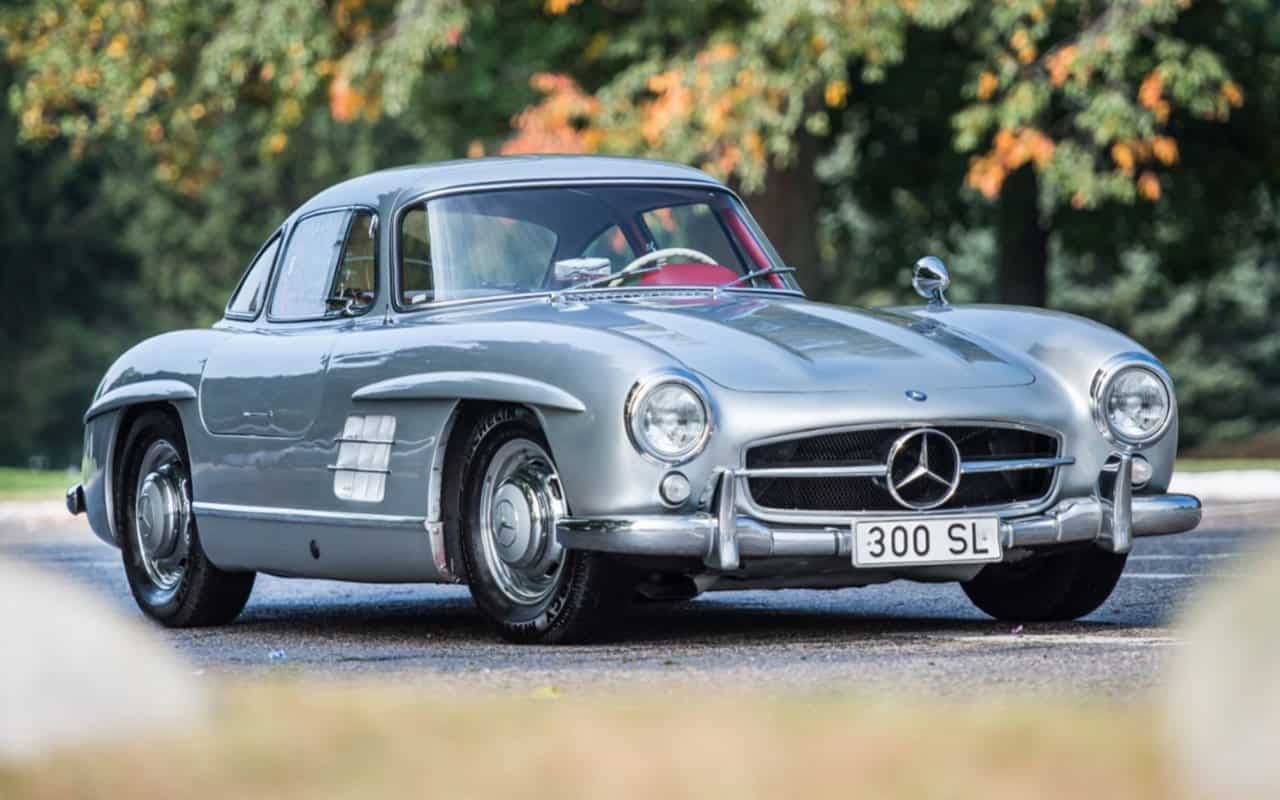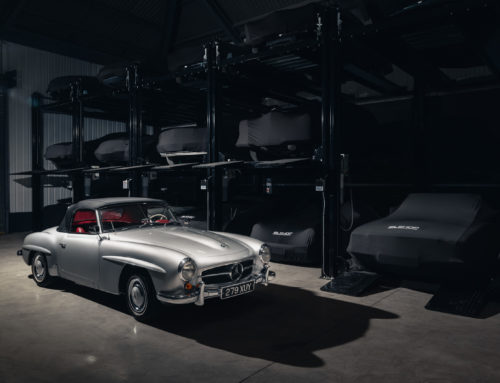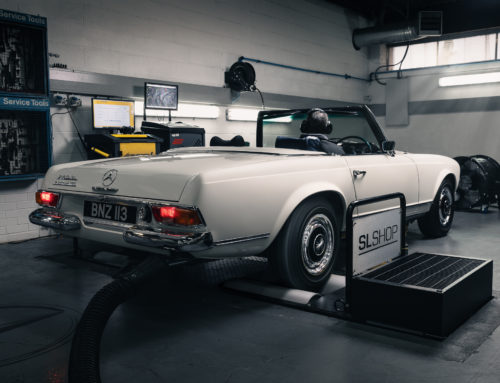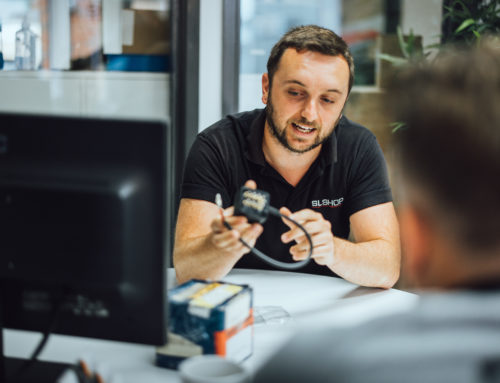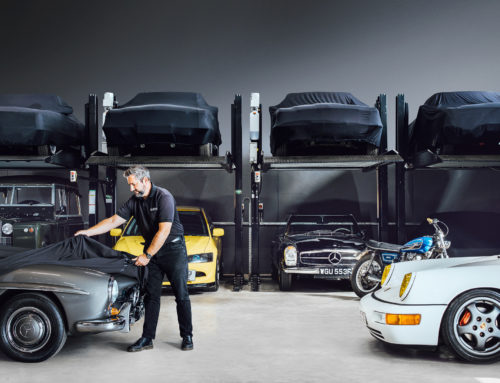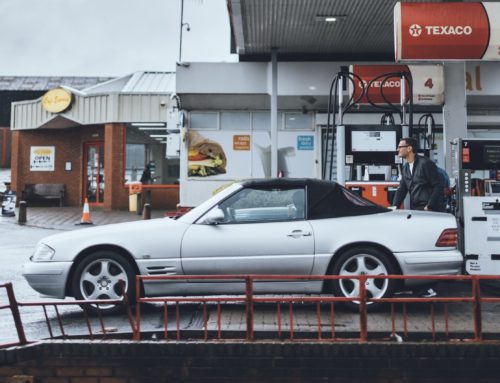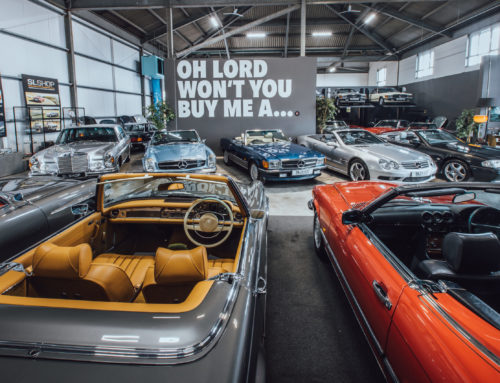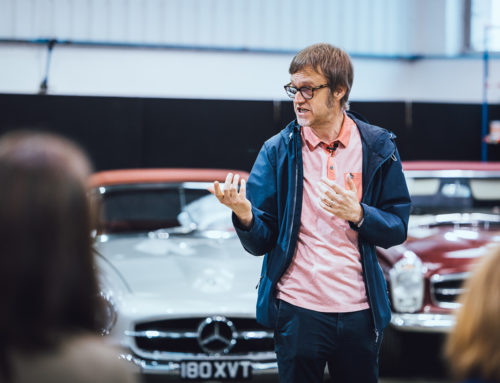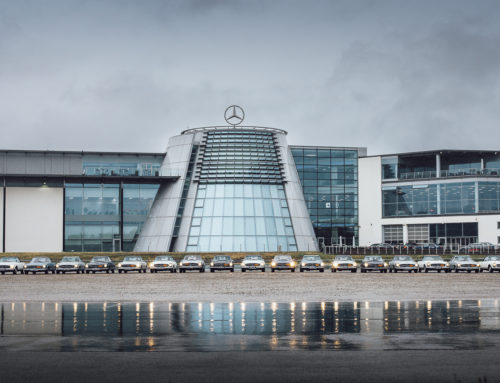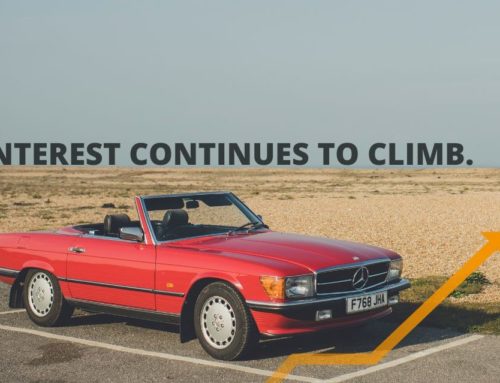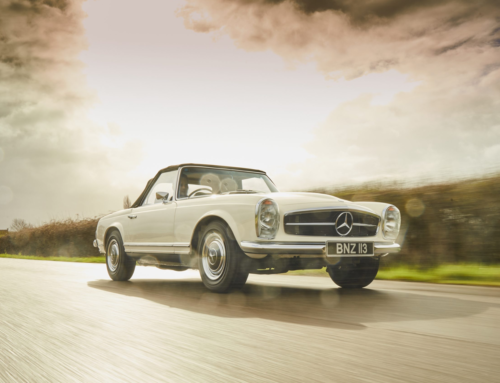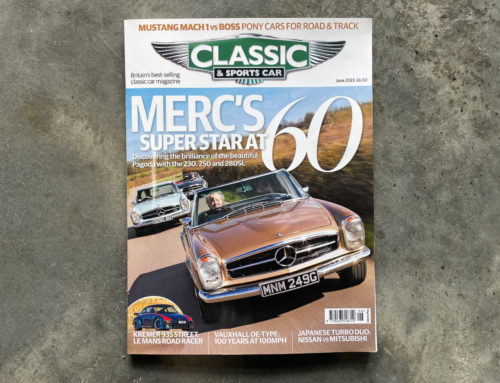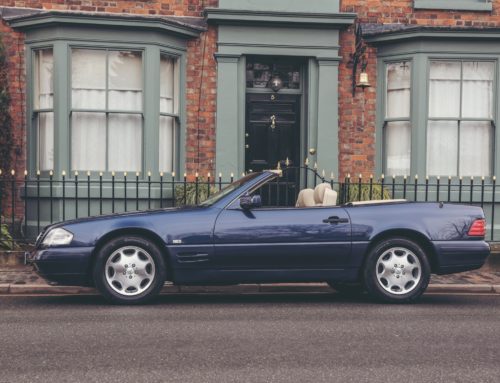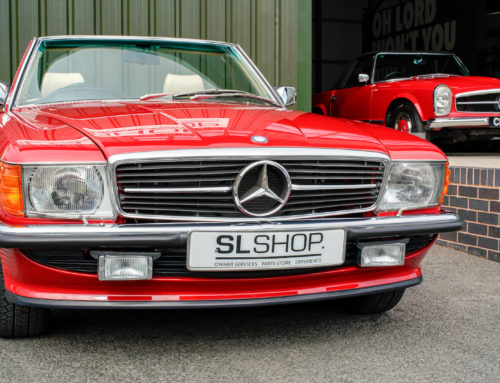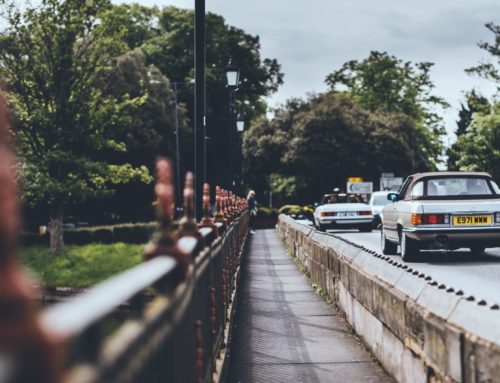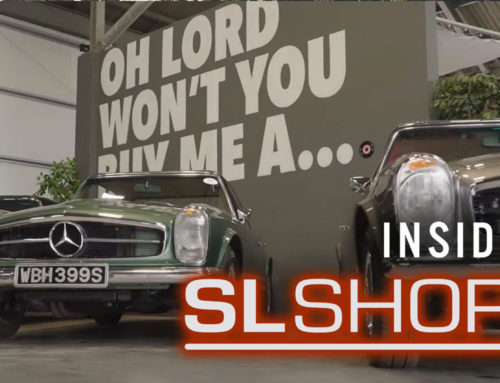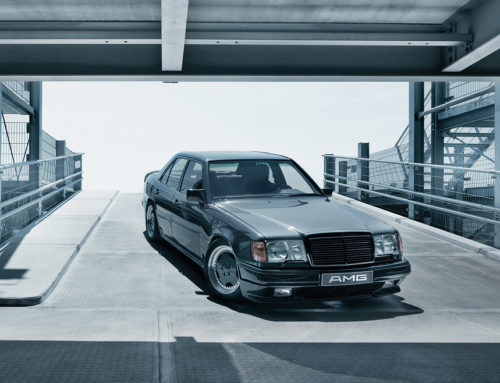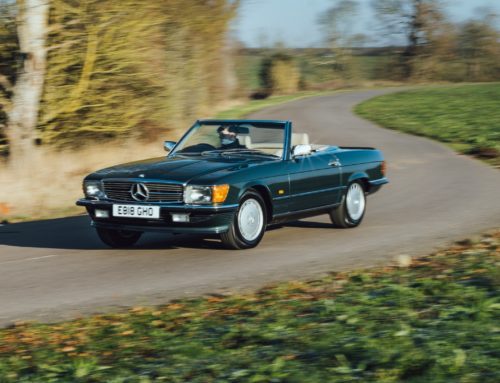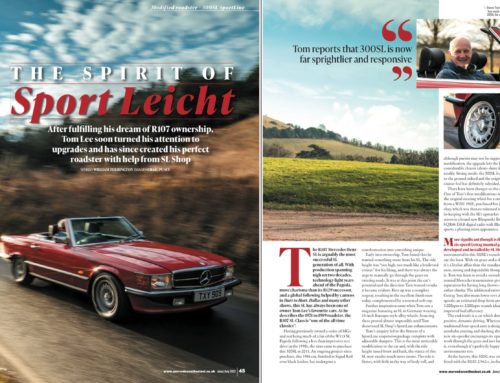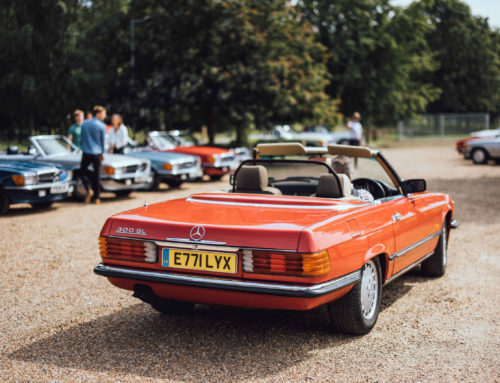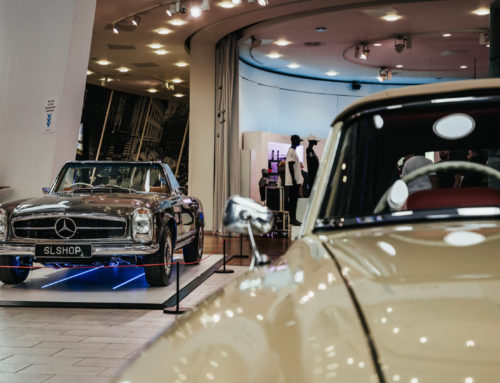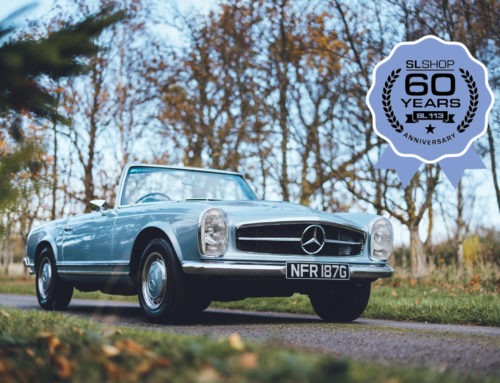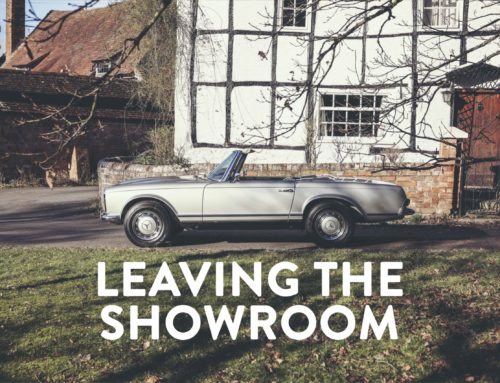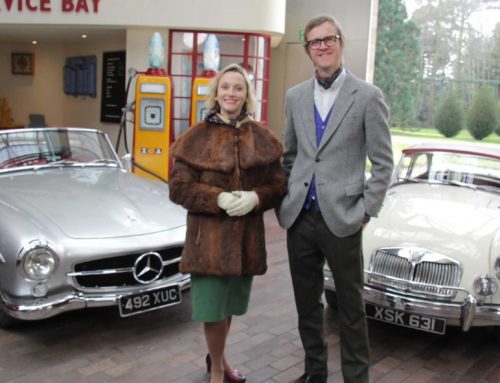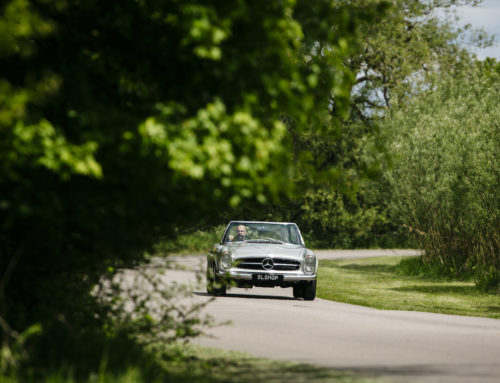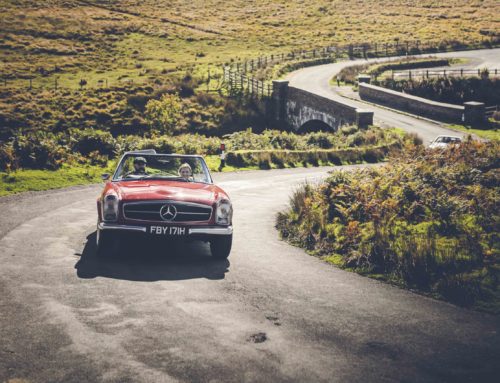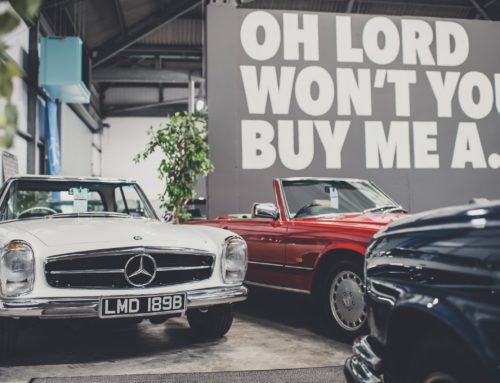1954 to 1963 – The W198 Mercedes-Benz SL
In 1950 Mercedes-Benz team manager Alfred Neubauer had witnessed 3 Jaguar XK120 cars at Le Mans, and was impressed by the all-new design from Britain. These cars heralded a new era of aerodynamics, but the three Jaguars were plagued by mechanical failures. Were it not for these breakdowns, Jaguar would have won the 1950 Le Mans race by a significant margin. It was apparent that Mercedes needed a lightweight, aerodynamic sports car with a production based drivetrain to ensure reliability in order to compete with the Jaguars. In 1951 that new car underwent initial testing at the Nurburgring. The first incarnation of the Mercedes-Benz SL was born.
The 300SL utilised a proper space frame chassis, meaning it was a space frame in the true sense (and not a glorified ladder frame). It was designed with aerodynamics and weight reduction in mind from the start, the lack of doors being the result of the quest for lightweight strength. During the first testing of the car, it was merely a spaceframe, engine and drivetrain – with no bodywork and therefore no doors!
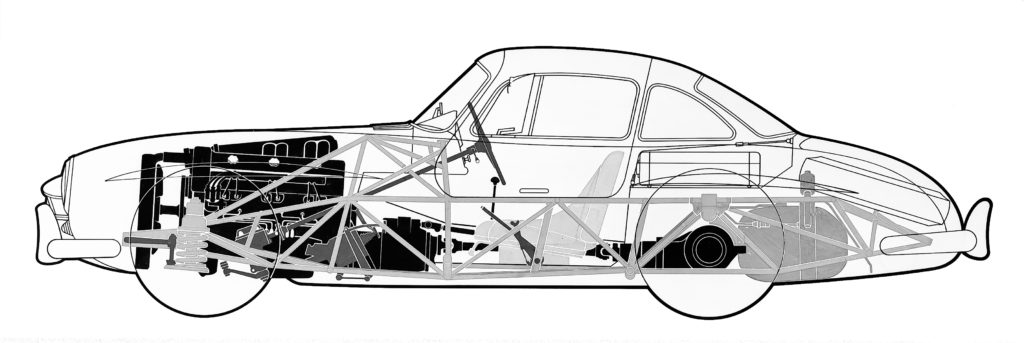
The design of the structurally integral space frame tubes did not allow for a traditional hinged door. Jaguar’s solution to this problem was to use a much smaller traditional door which extended downward low into the sills, however Mercedes took a different approach. Instead of compromising strength by opening the door down into the sides of the car, they extended the opening aperture up and into the roof, with a central hinge, and at that moment, the gullwing door was born.
What began as a simple necessity became an icon of automotive design.
The road going version of the Mercedes-Benz 300SL was unveiled at the International Motor Sports Show in New York in January 1954, known internally as W198.
The automotive press were amazed by the new car, and it was instantly desirable. The intensive nature of hand built production and that spaceframe chassis made the 300SL expensive to build and buy.
To satisfy the growing sales demand, particularly in the USA, Mercedes needed a car that could inspire desire like the 300SL while borrowing heavily from the established Mercedes production car parts bin… it had to have 100% of the beauty and 50% of the costs… so that is what they built…
W198 300SL Engines:
300 SL Gullwing 1954–1957, 3.0 litre inline 6, 211 hp (M 198 III)
300 SL Roadster) 1957–1963 3.0 litre inline 6, 221 hp (M 198 III)
1955 to 1963 – The W121 190 Mercedes-Benz SL
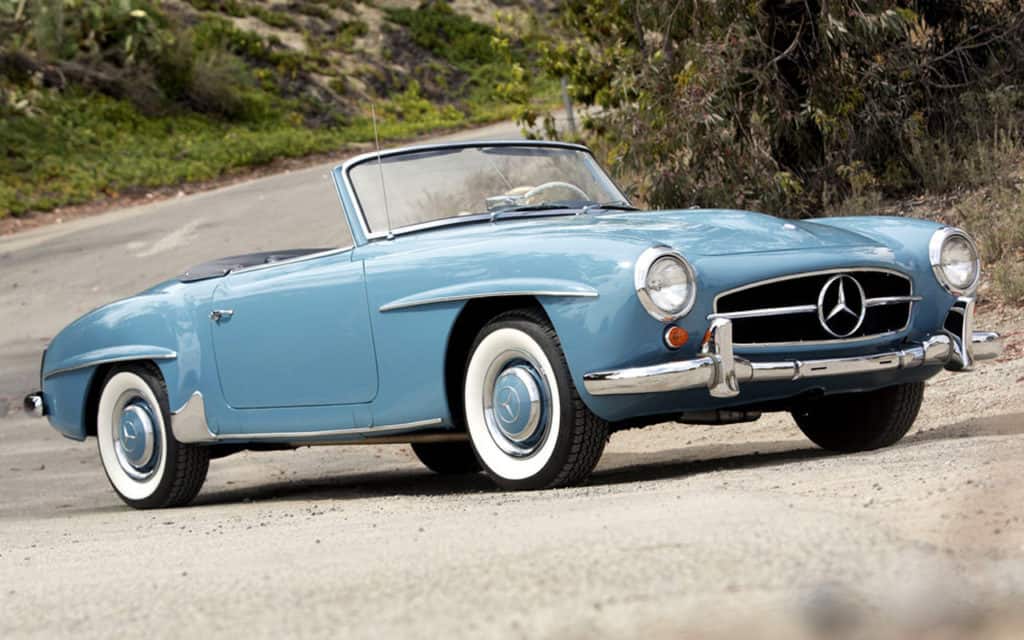
While the 300SL Gullwing was being sold in the USA for nearly $7,000, the 190SL came in at just $3,998. At this price, it was still more expensive than European rivals but had higher levels of sophistication and style. It was also more practical and reliable than any Italian offering.
The 190SL could be ordered as a convertible or a coupe with removable hard top, a format the SL would adopt for further generations.
The 300SL and 190SL had proven to Mercedes that this corner of the automotive market was ripe for the picking, and by 1958 a replacement was being conceived…
W121 190SL Engines:
190 SL, 1955–1963, 1.9 litre inline 4, 102 hp (M121)
SHOP W121 190 SL PARTS
1963 to 1971 – The W113 Pagoda SL
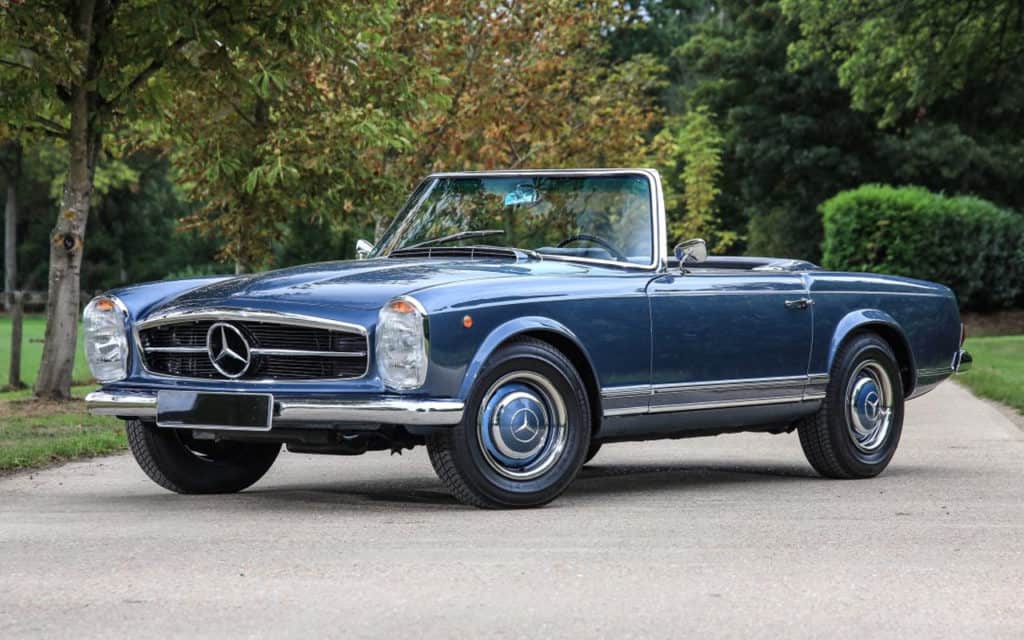
The original 300SL was fast, powerful, raw and elegant, but with half the horsepower, the 190SL was more show than go. As more Ferrari road cars began to appear and Jaguar’s XK program hit full swing, Mercedes needed a car that offered style, sophistication and sporting credentials whilst remaining affordable for the target audience. Aston Martin’s new DB4, Jaguar’s XK140, Porsche’s 356 (and soon to arrive 911) the Facel Vega and to some degree the V8 corvettes were all changing the landscape of the consumer car market of the era.
The Pagoda represented the first Mercedes-Benz SL that was not entirely inspired by race track exploits of other cars. The 300SL was a racer for the road, the 190SL was styled like the racer but lacked the necessary ooomph to be a proper sports car. The Pagoda’s six cylinder engine and clever design realigned the SL name to luxury, convenience and ample power.
Instead of being a toned town racer for the road, it was a road car and tourer in it’s own right.
This new car was to combine some of the speed and panache of the 300SL with the best qualities of the 190SL, the handling, neat packaging and production costs. It would be easier to use and live with than both the 300SL and 190SL, setting a new standard in what a road car was capable of in terms of more than just outright performance.
Not only was the Pagoda more luxurious than the 190SL, but it offered greater safety thanks to an early form of a crumple zone. The Pagoda was the first sports car to incorporate ‘designed in’ safety, something we now take for granted.
The new Pagoda used a six cylinder fuel injected engine, shared by the 220 Fintails, offering around 150bhp, significantly more than the 102bhp of the 190SL. This engine was already established as being both reliable and smooth, two Mercedes trademarks. As production progressed this engine grew from 2.3, to 2.5 and finally 2.8 litre displacement.
Mercedes’ move away from racing and towards luxury was bold, but the customer response proved them right. Of the almost 49,000 cars sold, 77% of Pagodas were optioned with automatic transmission, proving that buyers were more interested in comfortable cruising than pushing the limits.
The next SL would develop this concept further, offering greater convenience and even more sumptuous luxury…
W113 Pagoda SL Engines:
230 SL 1963-67, 2.3 litre inline 6, 150 hp (M127)
250 SL 1968-68, 2.5 litre inline 6, 150 hp (M129)
280 SL 1967-71, 2.8 litre inline 6, 170 hp (M130)
1971 to 1985 – The R107 SL – Early Cars
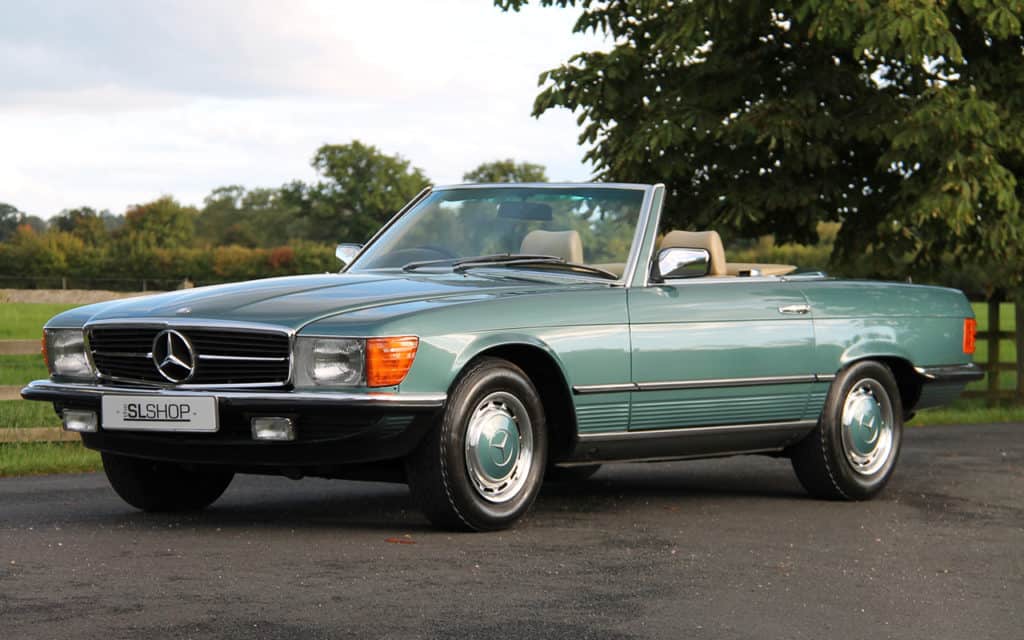
By the late 1960s the motoring world was evolving. Cars were expected to pollute less, use less fuel, look after occupants better… In short, sports cars had to change. Not content with power output strangling emissions regulations, the Americans were even considering a full ban on open cars! This was a major concern for Mercedes, as the USA and in particular California was a key export market.
With all of this in mind, the Pagoda’s replacement had to be a a car of many talents, and oh boy was it.
The new design retained the beauty of the Pagoda, pinned around that consistent hip line that began at the headlights and ran almost dead straight to the tail lights. An R107 is a wonderful package of straight lines and hidden curves, wrapped in just enough chrome. At a glance the amount of chrome adorning an Mercedes-Benz R107 SL is not immediately obvious, but never say that within earshot of someone who has restored one!
From a safety point of view, the R 107 picked up where the Pagoda left off. Strong construction and meaty A pillars offered roll over protection, ABS arrived in 1980 with airbag and belt tensioner offered the following January. The build quality and weight of this SL earned it the affectionate nickname ‘the tank’.
Offering a range of six-cylinder and V8 engines, the new SL had ample power for all markets, finding buyers around the world. Varying emissions standards between countries meant engines were presented in different levels of tune depending on the destination country. American legislation was particularly harsh, forcing manufacturers to produce engines of larger displacement in order to match the performance of the pre-regulation cars.
We’ll cover the 1981-86 SL model range in much more detail in future posts.
R107 SL Engines (early cars):
350 SL 1971–1972, 3.5 litre V8, 197 hp (M116 E35)
450 SL 1973–1980, 4.5 litre V8, 222 hp (M117 E45)
280 SL 1974–1985, 2.8 litre inline 6, 182 hp (M110 E28)
380 SL 1980–1986, 3.8 litre V8, 215 hp (M116 E38)
500 SL 1980–1986, 5.0 litre V8, 237 hp (M117 E50)
1986 to 1989 – The R107 SL – Late Cars
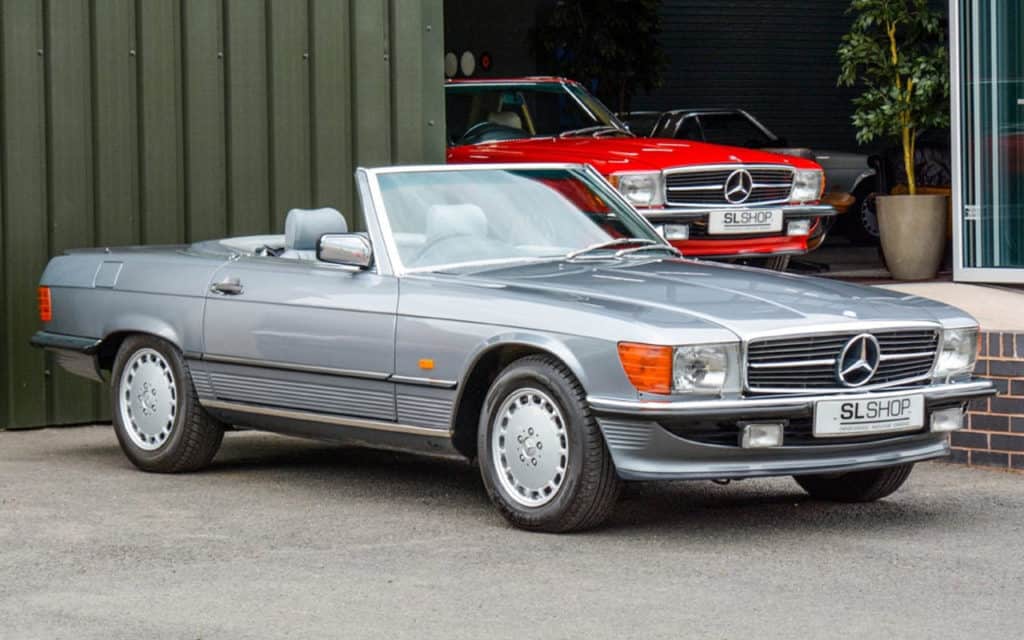
Introduced in 1986 for the last three years of production, the late model R107 was significantly improved. New engines, better suspension and improved brakes made for a more complete package, finished off with a lower front air dam and 15 inch alloy wheels – after all, by this stage the R107 SL had been in showrooms for 15 years!
These later SLs are now among the most desirable of all the generations listed on this page.
We’ll cover the 1986-89 facelift in much more detail in future posts.
All in all, 231,287 R and C 107 SL and SLCs were built between 1971 and 1989.
R107 SL Engines (late cars):
300 SL 1986–1989, 3.0 litre inline 6, 187hp (M103 E30)
420 SL 1986–1989, 4.2 litre V8, 215 hp (M116 E42)
500 SL 1986–1989, 5.0 litre V8, 237 hp (M117 E50)
560 SL 1986–1989, 5.6 litre V8, 227hp (M117 E60)
1989 to 2002 – The R129 SL
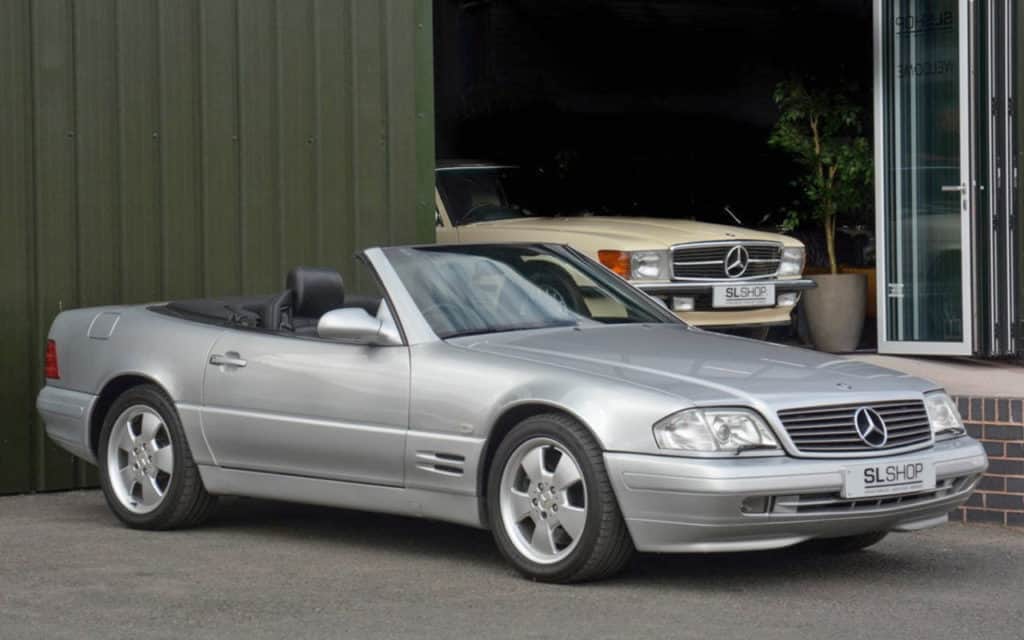
18 years is a very long time in terms of automotive development, meaning the R129 was destined to be a significant departure from the car it replaced. The manually operated roof was gone, replaced by a fully electronic canvas hood and of course, a removable hard top. Developed alongside the already well established and superbly solid W124 saloon, the R129 felt sure footed and reassuringly well put together. Critics at the time called the styling too conservative, but that didn’t stop the sales – the R129 was a roaring success in showrooms.
The R129 was the first Mercedes SL to use a V6 engine, the M112, which was a first for Mercedes-Benz. This superb powerplant was used across the range, powering C, E, S, SLK, G and ML Class cars as well as the Chrysler Crossfire.
There were many special edition R129 cars produced to mark various occasions, including Mille Miglia, Special Edition, SL Edition, Final Edition and the most desirable of all, the Silver Arrows.
Want to find out more? Read our Mercedes-Benz R129 Buying Guide
R129 SL Engines:
(Not all engines were offered in North America)
300 SL (12 valve) 1989-1993, 3.0 litre inline 6, 188 hp (M103)
300 SL (24 valve) 1989-1993, 3.0 litre inline 6, 228 hp (M104)
500 SL (32 valve) 1989-1993, 5.0 litre V8, 322 hp (M119)
600 SL (48 valve) 1992-2002, 6.0 litre V12, 389 hp (M120)
SL 280 (24 valve) 1993-1998, 2.8 litre inline 6, 190 hp (M104)
SL 320 (24 valve) 1993-1998, 3.2 litre inline 6, 228 hp (M104)
SL 500 (32 valve) 1993-1998, 5.0 litre V8, 322 hp (M119)
SL 280 (18 valve) 1998-2002, 2.8 litre V6, 201 hp (M112)
SL 320 (18 valve) 1998-2002, 3.2 litre V6, 221 hp (M112)
SL 500 (24 valve) 1998-2002, 5.0 litre V8, 302 hp (M113)
AMG 500 SL, 1991-1993, 6.0 litre V8 (M113)
SL60 AMG, 1993-1998, 6.0 litre V8, 375 hp (M113)
SL72 AMG, 1995, 7.1 litre V12, 500 hp (M120)
SL70 AMG, 1996-1997, 7.1 litre V12, 489 hp (M120)
SL73 AMG, 1997-2001, 7.3 litre V12, 518 hp (M297)
SL55 AMG, 1998-2001, 5.4 litre V8, 349hp (M113)
2002 to 2007 – The R230 SL
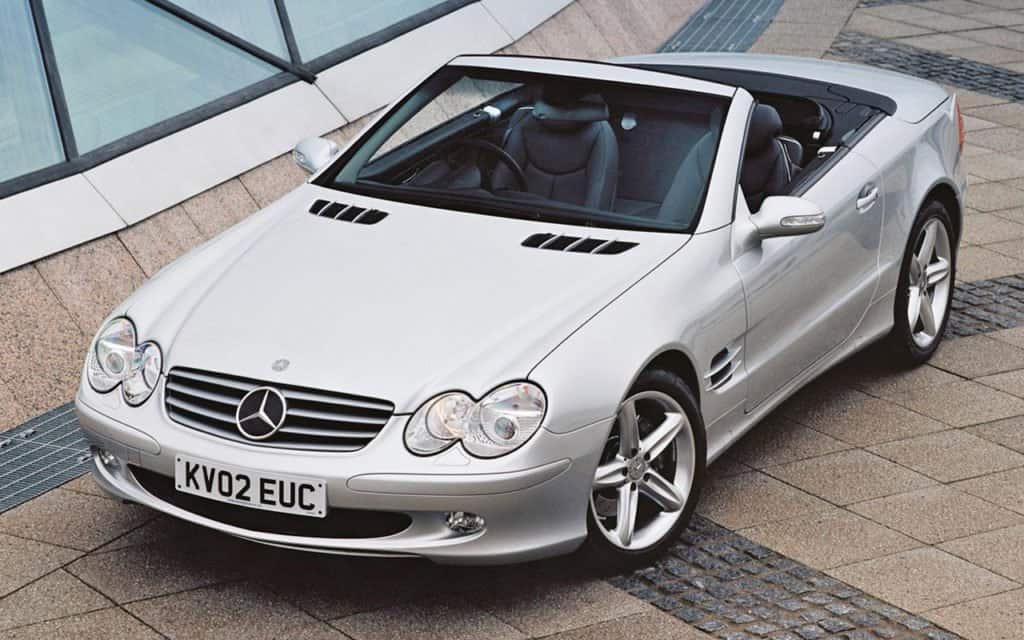
The R129 would survive until 2002, but by 1996 a replacement was well underway. The R230 remained an accomplished grand tourer like SLs before it, but unlike the 113, 107 and 129, this SL was poaching buyers of established sports cars. It’s not that the R230 SL moved away from the ‘luxury and convenience’ of previous generations, it’s just that it offered ‘luxury and convenience’ while keeping up with a Porsche 911 Cabriolet on properly twisty roads.
Technology began to play a significant role with the R230, a trend that developed with the (then) electronically advanced R129. R230 SLs benefitted from Active Body Control, which was being used in the W215 CL Class, allowing the car to lean into corners, flattening itself to the road for optimum grip.
It was technology that proved a huge selling point of the R230 SL – that clever and elegant electronically operated Vario folding roof. It turned the car into a ‘proper’ coupe at the flick of a switch, with no need for a removable hardtop.
The relationship between AMG and Mercedes-Benz had developed through the R129, but by the time the R230 came along it was fully established. Less than 2000 R129 SLs left the factory with AMG badging – The R230 would take the AMG badge mainstream.
We’ll be publishing more content on this generation of SL in due course, including a buying guide and our hot picks of which model and specification to choose.
R230 SL Engines:
SL 350, 2002–2006, 3724cc V6, 242 hp (M112)
SL 350, 2006–2008, 3498cc V6, 268 hp (M272)
SL 500, 2002–2006, 4966cc V8, 302 hp (M113)
SL 500, 2006–2008, 5461cc V8, 383 hp (M273)
SL 550, 2006–2008, 5461cc V8, 383 hp (M273)
SL 600, 2003–2006, 5513cc, V12 BiTurbo, 493 hp (M275)
SL 600, 2006–2008, 5513cc V12 BiTurbo, 510 hp (M275)
SL 55 AMG, 2003–2006, 5439cc V8 supercharged, 493 hp (M113)
SL 55 AMG, 2006–2008, 5439cc V8 supercharged, 510 hp (M113)
SL 65 AMG, 2004-2006, 5980cc V12 BiTurbo, 604 hp (M275 AMG)
SL 65 AMG, 2006–2008, 5980cc V12 BiTurbo, 604 hp (M275 AMG)
2008 to 2011 – The R230 SL Facelift
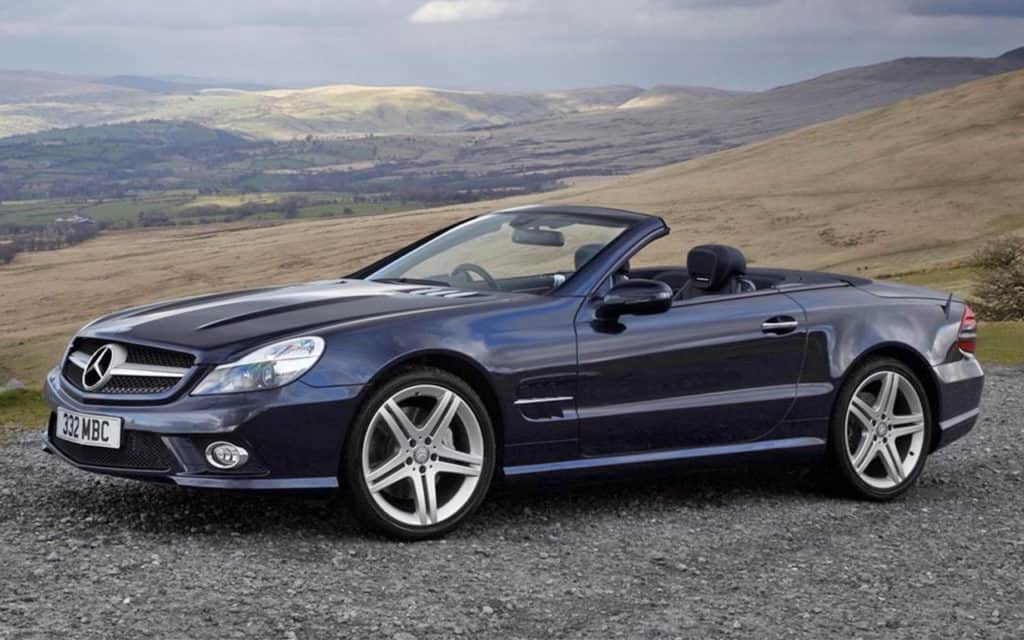
From 2008 the SL lost it’s distinctive headlights and gained a raft of new engines. AMG badged cars went from ‘hmmm, they might be getting a bit silly now’ to ‘yes, the plot has most definitely been lost‘ with the Black Series cars, which offered more power than could feasibly be put down on the road.
R230 SL Facelift Engines:
SL 280, 2008–2009, 2996cc V6, 228 hp (M272)
SL 300, 2009-2012, 2996cc V6, 228 hp (M272)
SL 350, 2008-2012, 3498cc V6, 312 hp (M272)
SL 500, 2008-2012, 5461cc V8, 383 hp (M273)
SL 550, 2008-2012, 5461cc V8, 383 hp (M273)
SL 63 AMG, 2008-2012, 6,208cc V8, 518 hp (M156.984)
SL 600, 2008-2009, 5,513 cc V12 BiTurbo, 510 hp (M275)
SL 65 AMG, 2008-2012, 5,980 cc V12 BiTurbo, 604 hp (M275 AMG)
SL 65 AMG Black Series, 2008-2012, 5,980 cc V12 BiTurbo, 661 hp (M275 AMG)
2013 to 2017 – The R231 SL
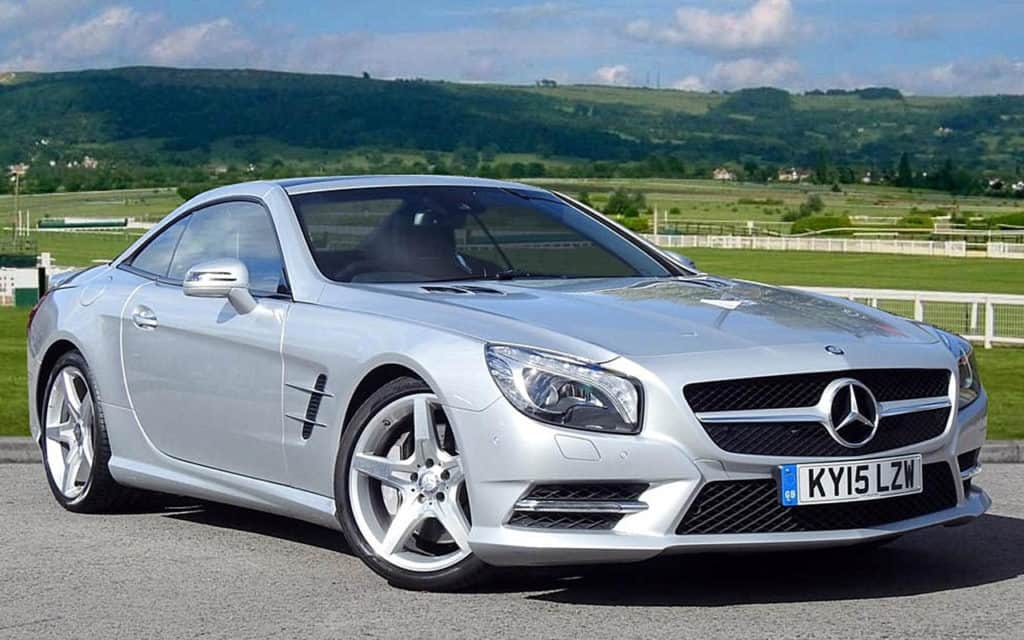
In 2013 the R231 SL arrived, bringing with it a 9-speed gearbox and some very questionably styled headlights.
R231 SL Engines:
SL 350, 2012-2014, 3,498cc V6, 302 hp (M276 DE35)
SL 400, 2014-2016, 2,996cc V6 BiTurbo, 328 hp
SL 450, 2017-Pres, 2,996 cc, 362 hp
SL 500, 2012-2015, 4,663cc V8 BiTurbo, 429 hp (M 278 DE 46 AL)
SL 550, 2012-2015, 4,663cc V8 BiTurbo, 429 hp (M 278 DE 46 AL)
SL 500, 2016-Pres, 4,663cc V8 BiTurbo, 449 hp (M 278 DE 46 AL)
SL 63 AMG, 2012-2014, 5,461cc V8 BiTurbo, 530 hp (M 157 DE 55 AL)
SL 63 AMG, 2015-Pres, 5,461cc V8 BiTurbo, 577 hp (M 157 DE 55 AL)
SL 65 AMG, 2012-Pres, 5,980cc V12 BiTurbo, 621 hp (M 279 E 60 AL)
2017 to Present – The R231 SL Facelift
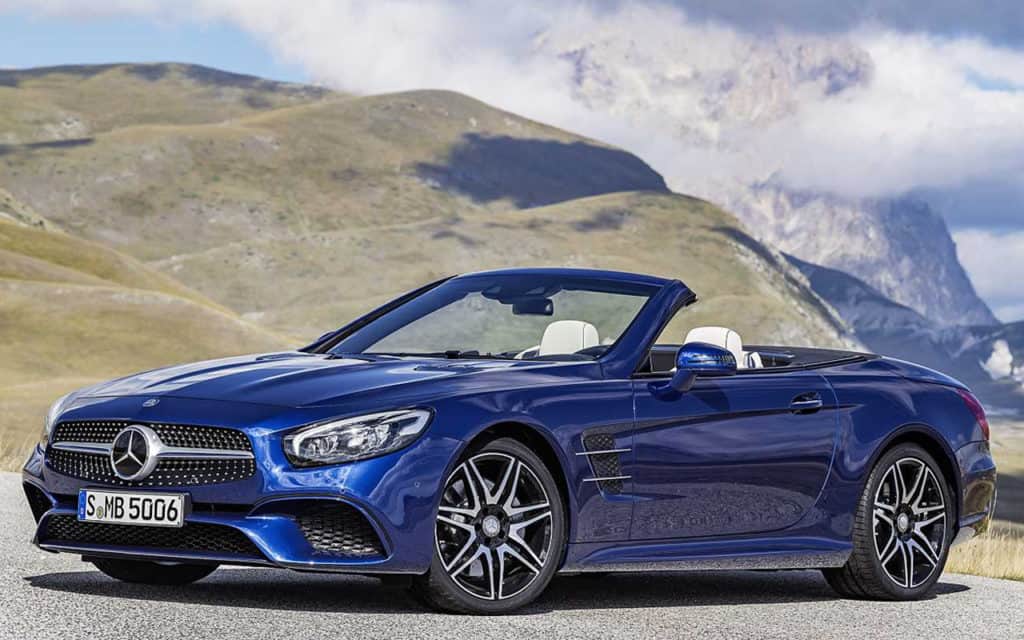
The facelift R231 model introduced a range of new colours and did away with the ‘marmite’ headlights of the previous iteration.
This latest SL offers advanced driver aids, park assist, brake assist, intelligent cruise control, a symphony of electronic trickery that stops short as being completely driverless.
At the ‘bottom’ of the current SL range sits a 3.0 litre V6 engine, packed with 362bhp – more than twice the power output of the very first six-cylinder SL…
Now more than 60 years on, the Mercedes-Benz SL name still represents the pinnacle of grand touring, luxury, performance, safety and technology.
The future of this iconic range may well be electric but we’ll take ours naturally aspirated, with a big old steering wheel, lashings of chrome and a dash of MB Tex…
R231 SL Facelift Engines:
SL 450, 2017-present, 2,996cc V6, 362 hp
SL 500, 2016-present, 4,663cc V8 BiTurbo, 449 hp (M 278 DE 46 AL)
SL 63 AMG, 2015-present, 5,461cc V8 BiTurbo, 577 hp (M 157 DE 55 AL)
SL 65 AMG, 2012-present, 5,980cc V12 BiTurbo, 621 hp (M 279 E 60 AL)
2022 – The R232 AMG SL
New to the lineup is the R232, announced at the end of 2021. A marked departure from predecessors, the new SL arrived with the AMG designation as standard with all the newly offered variants. This standard setting signifies the last of the petrol-powered SL variants, paying homage to AMG more than the SL. You can find out more about the new model here.
R232 SL Engines:
SL55 4Matic+, 2022 -, 3,982cc V8 biturbo, 469 hp (M177 DE40 LA)
SL63 4Matic+, 2022 -, 3,982cc V8 biturbo, 577 hp (M177 DE40 LA)
A base six-cylinder and V8 will be announced over the course of 2022.
Did you enjoy our history of the SL? Did we miss something out, have you got something to add? Have you owned one of these cars and want to make an observation for our readers? Which is your favourite SL, or which is the best looking generation? Let us know in the comments below.
Share With Your Fellow Enthusiasts
1954 to 1963 – The W198 Mercedes-Benz SL
In 1950 Mercedes-Benz team manager Alfred Neubauer had witnessed 3 Jaguar XK120 cars at Le Mans, and was impressed by the all-new design from Britain. These cars heralded a new era of aerodynamics, but the three Jaguars were plagued by mechanical failures. Were it not for these breakdowns, Jaguar would have won the 1950 Le Mans race by a significant margin. It was apparent that Mercedes needed a lightweight, aerodynamic sports car with a production based drivetrain to ensure reliability in order to compete with the Jaguars. In 1951 that new car underwent initial testing at the Nurburgring. The first incarnation of the Mercedes-Benz SL was born.
The 300SL utilised a proper space frame chassis, meaning it was a space frame in the true sense (and not a glorified ladder frame). It was designed with aerodynamics and weight reduction in mind from the start, the lack of doors being the result of the quest for lightweight strength. During the first testing of the car, it was merely a spaceframe, engine and drivetrain – with no bodywork and therefore no doors!

The design of the structurally integral space frame tubes did not allow for a traditional hinged door. Jaguar’s solution to this problem was to use a much smaller traditional door which extended downward low into the sills, however Mercedes took a different approach. Instead of compromising strength by opening the door down into the sides of the car, they extended the opening aperture up and into the roof, with a central hinge, and at that moment, the gullwing door was born.
What began as a simple necessity became an icon of automotive design.
The road going version of the Mercedes-Benz 300SL was unveiled at the International Motor Sports Show in New York in January 1954, known internally as W198.
The automotive press were amazed by the new car, and it was instantly desirable. The intensive nature of hand built production and that spaceframe chassis made the 300SL expensive to build and buy.
To satisfy the growing sales demand, particularly in the USA, Mercedes needed a car that could inspire desire like the 300SL while borrowing heavily from the established Mercedes production car parts bin… it had to have 100% of the beauty and 50% of the costs… so that is what they built…
W198 300SL Engines:
300 SL Gullwing 1954–1957, 3.0 litre inline 6, 211 hp (M 198 III)
300 SL Roadster) 1957–1963 3.0 litre inline 6, 221 hp (M 198 III)
1955 to 1963 – The W121 190 Mercedes-Benz SL

While the 300SL Gullwing was being sold in the USA for nearly $7,000, the 190SL came in at just $3,998. At this price, it was still more expensive than European rivals but had higher levels of sophistication and style. It was also more practical and reliable than any Italian offering.
The 190SL could be ordered as a convertible or a coupe with removable hard top, a format the SL would adopt for further generations.
The 300SL and 190SL had proven to Mercedes that this corner of the automotive market was ripe for the picking, and by 1958 a replacement was being conceived…
W121 190SL Engines:
190 SL, 1955–1963, 1.9 litre inline 4, 102 hp (M121)
SHOP W121 190 SL PARTS
1963 to 1971 – The W113 Pagoda SL

The original 300SL was fast, powerful, raw and elegant, but with half the horsepower, the 190SL was more show than go. As more Ferrari road cars began to appear and Jaguar’s XK program hit full swing, Mercedes needed a car that offered style, sophistication and sporting credentials whilst remaining affordable for the target audience. Aston Martin’s new DB4, Jaguar’s XK140, Porsche’s 356 (and soon to arrive 911) the Facel Vega and to some degree the V8 corvettes were all changing the landscape of the consumer car market of the era.
The Pagoda represented the first Mercedes-Benz SL that was not entirely inspired by race track exploits of other cars. The 300SL was a racer for the road, the 190SL was styled like the racer but lacked the necessary ooomph to be a proper sports car. The Pagoda’s six cylinder engine and clever design realigned the SL name to luxury, convenience and ample power.
Instead of being a toned town racer for the road, it was a road car and tourer in it’s own right.
This new car was to combine some of the speed and panache of the 300SL with the best qualities of the 190SL, the handling, neat packaging and production costs. It would be easier to use and live with than both the 300SL and 190SL, setting a new standard in what a road car was capable of in terms of more than just outright performance.
Not only was the Pagoda more luxurious than the 190SL, but it offered greater safety thanks to an early form of a crumple zone. The Pagoda was the first sports car to incorporate ‘designed in’ safety, something we now take for granted.
The new Pagoda used a six cylinder fuel injected engine, shared by the 220 Fintails, offering around 150bhp, significantly more than the 102bhp of the 190SL. This engine was already established as being both reliable and smooth, two Mercedes trademarks. As production progressed this engine grew from 2.3, to 2.5 and finally 2.8 litre displacement.
Mercedes’ move away from racing and towards luxury was bold, but the customer response proved them right. Of the almost 49,000 cars sold, 77% of Pagodas were optioned with automatic transmission, proving that buyers were more interested in comfortable cruising than pushing the limits.
The next SL would develop this concept further, offering greater convenience and even more sumptuous luxury…
W113 Pagoda SL Engines:
230 SL 1963-67, 2.3 litre inline 6, 150 hp (M127)
250 SL 1968-68, 2.5 litre inline 6, 150 hp (M129)
280 SL 1967-71, 2.8 litre inline 6, 170 hp (M130)
1971 to 1985 – The R107 SL – Early Cars

By the late 1960s the motoring world was evolving. Cars were expected to pollute less, use less fuel, look after occupants better… In short, sports cars had to change. Not content with power output strangling emissions regulations, the Americans were even considering a full ban on open cars! This was a major concern for Mercedes, as the USA and in particular California was a key export market.
With all of this in mind, the Pagoda’s replacement had to be a a car of many talents, and oh boy was it.
The new design retained the beauty of the Pagoda, pinned around that consistent hip line that began at the headlights and ran almost dead straight to the tail lights. An R107 is a wonderful package of straight lines and hidden curves, wrapped in just enough chrome. At a glance the amount of chrome adorning an Mercedes-Benz R107 SL is not immediately obvious, but never say that within earshot of someone who has restored one!
From a safety point of view, the R 107 picked up where the Pagoda left off. Strong construction and meaty A pillars offered roll over protection, ABS arrived in 1980 with airbag and belt tensioner offered the following January. The build quality and weight of this SL earned it the affectionate nickname ‘the tank’.
Offering a range of six-cylinder and V8 engines, the new SL had ample power for all markets, finding buyers around the world. Varying emissions standards between countries meant engines were presented in different levels of tune depending on the destination country. American legislation was particularly harsh, forcing manufacturers to produce engines of larger displacement in order to match the performance of the pre-regulation cars.
We’ll cover the 1981-86 SL model range in much more detail in future posts.
R107 SL Engines (early cars):
350 SL 1971–1972, 3.5 litre V8, 197 hp (M116 E35)
450 SL 1973–1980, 4.5 litre V8, 222 hp (M117 E45)
280 SL 1974–1985, 2.8 litre inline 6, 182 hp (M110 E28)
380 SL 1980–1986, 3.8 litre V8, 215 hp (M116 E38)
500 SL 1980–1986, 5.0 litre V8, 237 hp (M117 E50)
1986 to 1989 – The R107 SL – Late Cars

Introduced in 1986 for the last three years of production, the late model R107 was significantly improved. New engines, better suspension and improved brakes made for a more complete package, finished off with a lower front air dam and 15 inch alloy wheels – after all, by this stage the R107 SL had been in showrooms for 15 years!
These later SLs are now among the most desirable of all the generations listed on this page.
We’ll cover the 1986-89 facelift in much more detail in future posts.
All in all, 231,287 R and C 107 SL and SLCs were built between 1971 and 1989.
R107 SL Engines (late cars):
300 SL 1986–1989, 3.0 litre inline 6, 187hp (M103 E30)
420 SL 1986–1989, 4.2 litre V8, 215 hp (M116 E42)
500 SL 1986–1989, 5.0 litre V8, 237 hp (M117 E50)
560 SL 1986–1989, 5.6 litre V8, 227hp (M117 E60)
1989 to 2002 – The R129 SL

18 years is a very long time in terms of automotive development, meaning the R129 was destined to be a significant departure from the car it replaced. The manually operated roof was gone, replaced by a fully electronic canvas hood and of course, a removable hard top. Developed alongside the already well established and superbly solid W124 saloon, the R129 felt sure footed and reassuringly well put together. Critics at the time called the styling too conservative, but that didn’t stop the sales – the R129 was a roaring success in showrooms.
The R129 was the first Mercedes SL to use a V6 engine, the M112, which was a first for Mercedes-Benz. This superb powerplant was used across the range, powering C, E, S, SLK, G and ML Class cars as well as the Chrysler Crossfire.
There were many special edition R129 cars produced to mark various occasions, including Mille Miglia, Special Edition, SL Edition, Final Edition and the most desirable of all, the Silver Arrows.
Want to find out more? Read our Mercedes-Benz R129 Buying Guide
R129 SL Engines:
(Not all engines were offered in North America)
300 SL (12 valve) 1989-1993, 3.0 litre inline 6, 188 hp (M103)
300 SL (24 valve) 1989-1993, 3.0 litre inline 6, 228 hp (M104)
500 SL (32 valve) 1989-1993, 5.0 litre V8, 322 hp (M119)
600 SL (48 valve) 1992-2002, 6.0 litre V12, 389 hp (M120)
SL 280 (24 valve) 1993-1998, 2.8 litre inline 6, 190 hp (M104)
SL 320 (24 valve) 1993-1998, 3.2 litre inline 6, 228 hp (M104)
SL 500 (32 valve) 1993-1998, 5.0 litre V8, 322 hp (M119)
SL 280 (18 valve) 1998-2002, 2.8 litre V6, 201 hp (M112)
SL 320 (18 valve) 1998-2002, 3.2 litre V6, 221 hp (M112)
SL 500 (24 valve) 1998-2002, 5.0 litre V8, 302 hp (M113)
AMG 500 SL, 1991-1993, 6.0 litre V8 (M113)
SL60 AMG, 1993-1998, 6.0 litre V8, 375 hp (M113)
SL72 AMG, 1995, 7.1 litre V12, 500 hp (M120)
SL70 AMG, 1996-1997, 7.1 litre V12, 489 hp (M120)
SL73 AMG, 1997-2001, 7.3 litre V12, 518 hp (M297)
SL55 AMG, 1998-2001, 5.4 litre V8, 349hp (M113)
2002 to 2007 – The R230 SL

The R129 would survive until 2002, but by 1996 a replacement was well underway. The R230 remained an accomplished grand tourer like SLs before it, but unlike the 113, 107 and 129, this SL was poaching buyers of established sports cars. It’s not that the R230 SL moved away from the ‘luxury and convenience’ of previous generations, it’s just that it offered ‘luxury and convenience’ while keeping up with a Porsche 911 Cabriolet on properly twisty roads.
Technology began to play a significant role with the R230, a trend that developed with the (then) electronically advanced R129. R230 SLs benefitted from Active Body Control, which was being used in the W215 CL Class, allowing the car to lean into corners, flattening itself to the road for optimum grip.
It was technology that proved a huge selling point of the R230 SL – that clever and elegant electronically operated Vario folding roof. It turned the car into a ‘proper’ coupe at the flick of a switch, with no need for a removable hardtop.
The relationship between AMG and Mercedes-Benz had developed through the R129, but by the time the R230 came along it was fully established. Less than 2000 R129 SLs left the factory with AMG badging – The R230 would take the AMG badge mainstream.
We’ll be publishing more content on this generation of SL in due course, including a buying guide and our hot picks of which model and specification to choose.
R230 SL Engines:
SL 350, 2002–2006, 3724cc V6, 242 hp (M112)
SL 350, 2006–2008, 3498cc V6, 268 hp (M272)
SL 500, 2002–2006, 4966cc V8, 302 hp (M113)
SL 500, 2006–2008, 5461cc V8, 383 hp (M273)
SL 550, 2006–2008, 5461cc V8, 383 hp (M273)
SL 600, 2003–2006, 5513cc, V12 BiTurbo, 493 hp (M275)
SL 600, 2006–2008, 5513cc V12 BiTurbo, 510 hp (M275)
SL 55 AMG, 2003–2006, 5439cc V8 supercharged, 493 hp (M113)
SL 55 AMG, 2006–2008, 5439cc V8 supercharged, 510 hp (M113)
SL 65 AMG, 2004-2006, 5980cc V12 BiTurbo, 604 hp (M275 AMG)
SL 65 AMG, 2006–2008, 5980cc V12 BiTurbo, 604 hp (M275 AMG)
2008 to 2011 – The R230 SL Facelift

From 2008 the SL lost it’s distinctive headlights and gained a raft of new engines. AMG badged cars went from ‘hmmm, they might be getting a bit silly now’ to ‘yes, the plot has most definitely been lost‘ with the Black Series cars, which offered more power than could feasibly be put down on the road.
R230 SL Facelift Engines:
SL 280, 2008–2009, 2996cc V6, 228 hp (M272)
SL 300, 2009-2012, 2996cc V6, 228 hp (M272)
SL 350, 2008-2012, 3498cc V6, 312 hp (M272)
SL 500, 2008-2012, 5461cc V8, 383 hp (M273)
SL 550, 2008-2012, 5461cc V8, 383 hp (M273)
SL 63 AMG, 2008-2012, 6,208cc V8, 518 hp (M156.984)
SL 600, 2008-2009, 5,513 cc V12 BiTurbo, 510 hp (M275)
SL 65 AMG, 2008-2012, 5,980 cc V12 BiTurbo, 604 hp (M275 AMG)
SL 65 AMG Black Series, 2008-2012, 5,980 cc V12 BiTurbo, 661 hp (M275 AMG)
2013 to 2017 – The R231 SL

In 2013 the R231 SL arrived, bringing with it a 9-speed gearbox and some very questionably styled headlights.
R231 SL Engines:
SL 350, 2012-2014, 3,498cc V6, 302 hp (M276 DE35)
SL 400, 2014-2016, 2,996cc V6 BiTurbo, 328 hp
SL 450, 2017-Pres, 2,996 cc, 362 hp
SL 500, 2012-2015, 4,663cc V8 BiTurbo, 429 hp (M 278 DE 46 AL)
SL 550, 2012-2015, 4,663cc V8 BiTurbo, 429 hp (M 278 DE 46 AL)
SL 500, 2016-Pres, 4,663cc V8 BiTurbo, 449 hp (M 278 DE 46 AL)
SL 63 AMG, 2012-2014, 5,461cc V8 BiTurbo, 530 hp (M 157 DE 55 AL)
SL 63 AMG, 2015-Pres, 5,461cc V8 BiTurbo, 577 hp (M 157 DE 55 AL)
SL 65 AMG, 2012-Pres, 5,980cc V12 BiTurbo, 621 hp (M 279 E 60 AL)
2017 to Present – The R231 SL Facelift

The facelift R231 model introduced a range of new colours and did away with the ‘marmite’ headlights of the previous iteration.
This latest SL offers advanced driver aids, park assist, brake assist, intelligent cruise control, a symphony of electronic trickery that stops short as being completely driverless.
At the ‘bottom’ of the current SL range sits a 3.0 litre V6 engine, packed with 362bhp – more than twice the power output of the very first six-cylinder SL…
Now more than 60 years on, the Mercedes-Benz SL name still represents the pinnacle of grand touring, luxury, performance, safety and technology.
The future of this iconic range may well be electric but we’ll take ours naturally aspirated, with a big old steering wheel, lashings of chrome and a dash of MB Tex…
R231 SL Facelift Engines:
SL 450, 2017-present, 2,996cc V6, 362 hp
SL 500, 2016-present, 4,663cc V8 BiTurbo, 449 hp (M 278 DE 46 AL)
SL 63 AMG, 2015-present, 5,461cc V8 BiTurbo, 577 hp (M 157 DE 55 AL)
SL 65 AMG, 2012-present, 5,980cc V12 BiTurbo, 621 hp (M 279 E 60 AL)
2022 – The R232 AMG SL
New to the lineup is the R232, announced at the end of 2021. A marked departure from predecessors, the new SL arrived with the AMG designation as standard with all the newly offered variants. This standard setting signifies the last of the petrol-powered SL variants, paying homage to AMG more than the SL. You can find out more about the new model here.
R232 SL Engines:
SL55 4Matic+, 2022 -, 3,982cc V8 biturbo, 469 hp (M177 DE40 LA)
SL63 4Matic+, 2022 -, 3,982cc V8 biturbo, 577 hp (M177 DE40 LA)
A base six-cylinder and V8 will be announced over the course of 2022.
Did you enjoy our history of the SL? Did we miss something out, have you got something to add? Have you owned one of these cars and want to make an observation for our readers? Which is your favourite SL, or which is the best looking generation? Let us know in the comments below.
Share With Your Fellow Enthusiasts
More from Journal
CARE
THE ULTIMATE CERTIFIED SERVICING INVESTMENT PLAN
Your ownership journey matters to us, which is why we have created a simple certified servicing investment plan, tailored to your individual needs and aspirations.
Start investing today and our dedicated CARE team will work with you to increase the value and enjoyment you receive from your vehicle.

STAY IN TUNE WITH SLSHOP MOMENTS
As part of SLSHOP’s community of enthusiasts, you’ll be the first to hear about events and tours, key product offers, exciting stories from owners around the world and of course… our latest additions to the showroom. So, be the first to know and you might just sneak a car on your driveway or take your car’s condition to new heights with our exclusive replacement parts.
Or, visit SLSHOP Journal
